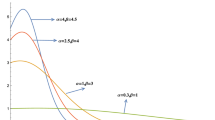Abstract
The theory of \(\sigma -\oplus \)-measure is a basic tool in soft computing. There are no studies on cumulative distribution function in pseudo-analysis. In this paper, we first introduce pseudo-cumulative distribution function. Then, some examples of this class are studied. Also, we analyze a real data set for the daily humidity of Basel’s city in period of 1985/01/01 to 2018/11/11 by the proposed pseudo-cumulative distribution function.







Similar content being viewed by others
References
Chau KW (2004) River stage forecasting with particle swarm optimization. Innov Appl Artif Intell 3029:1166–1173
Chau KW (2006) Particle swarm optimization training algorithm for ANNs in stage prediction of Shing Mun River. J Hydrol 329:363–367
Chau KW, Wu CL (2010) A hybrid model coupled with singular spectrum analysis for daily rainfall prediction. J Hydroinform 12(4):458–473
Fletcher SC, Ponnambalam K (1996) Estimation of reservoir yield and storage distribution using moments analysis. J Hydrol 182:259–275
Ganji A, Ponnambalam K, Khalili D (2006) Grain yield reliability analysis with crop water demand uncertainty. Stoch Env Res Risk Assess 20:259–277
Kolokoltsov VN, Maslov VP (1997) Idempotent analysis and its applications. Kluwer Academic Publishers, Dordrecht
Koutsoyiannis D, Xanthopoulos T (1989) On the parametric approach to unit hydrograph identification. Water Resour Manag 3:107–128
Kuich W (1986) Semirings, automata languages. Springer, Berlin
Kumaraswamy P (1980) Generalized probability density-function for double-bounded random-processes. J Hydrol 46:79–88
Litvinov GL, Maslov VP (1996) Idempotent mathematics: correspondence principle and applications. Russ Math Surv 51:1210–1211
McDonald JB (1984) Some generalized functions for the size distribution of income. Econometrica 52:647–664
Mehri-Dehnavi H, Agahi H, Mesiar R (2019) Pseudo-exponential distribution and its statistical applications in econophysics. Soft Comput 23(1):357–363
Mesiar R, Pap E (1999) Idempotent integral as limit of \(g\) -integrals. Fuzzy Sets Syst 102:385–392
Nadarajah S (2008) On the distribution of Kumaraswamy. J Hydrol 348:568–569
Pap E (1993) \(g\)-calculus, Univ. u Novom Sadu Zb. Rad Prirod Mat Fak Ser Mat 23:145–156
Pap E (1995) Null-additive set functions. Kluwer Academic Publishers, Dordrecht
Pap E (1997) Pseudo-analysis as a mathematical base for soft computing. Soft Comput 1:61–68
Pap E (2002) Pseudo-additive measures and their applications. In: Pap E (ed) Handbook of measure theory, vol II. Elsevier, Amsterdam, pp 1403–1465
Pap E (2005) Application of the generated pseudo-analysis on nonlinear partial differential equations. In: Litvinov GL, Maslov VP (eds) Proceedings of the conference on idempotent mathematics and mathematical physics, contemporary mathematics, vol 377. American Mathematical Society, New York, pp 239–259
Pap E (2008) Pseudo-analysis approach to nonlinear partial differential equations. Acta Polytechnica Hungarica 5:31–45
Pap E, Ralević N (1998) Pseudo-Laplace transform. Nonlinear Anal 33:553–560
Pap E, Štajner I (1999) Generalized pseudo-convolution in the theory of probabilistic metric spaces, information, fuzzy numbers, optimization, system theory. Fuzzy Sets Syst 102:393–415
Pap E, Štrboja M, Rudas I (2014) Pseudo-\(L^{p}\) space and convergence. Fuzzy Sets Syst 238:113–128
Sundar V, Subbiah K (1989) Application of double bounded probability density-function for analysis of ocean waves. Ocean Eng 16:193–200
Taormina R, Chau K-W (2015) Data-driven input variable selection for rainfall-runoff modeling using binary-coded particle swarm optimization and Extreme Learning Machines. J Hydrol 529(3):1617–1632
Wang WC, Chau K-W, Xu D-M, Chen X-Y (2015) Improving forecasting accuracy of annual runoff time series using ARIMA based on EEMD decomposition. Water Resour Manag 29(8):2655–2675
Acknowledgements
The authors are very grateful to the anonymous reviewers for their suggestions. Hamzeh Agahi was supported by Babol Noshirvani University of Technology with Grant program No. BNUT/392100/1400. Hossein Mehri-Dehnavi was supported by Babol Noshirvani University of Technology with Grant program No. BNUT/390012/1400.
Author information
Authors and Affiliations
Corresponding author
Ethics declarations
Conflict of interest
The authors declare that they have no conflict of interest.
Ethical approval
This article does not contain any studies with human participants or animals performed by any of the authors.
Additional information
Publisher's Note
Springer Nature remains neutral with regard to jurisdictional claims in published maps and institutional affiliations.
Rights and permissions
About this article
Cite this article
Agahi, H., Mehri-Dehnavi, H. Pseudo-cumulative distribution function with applications. Soft Comput 25, 9693–9702 (2021). https://doi.org/10.1007/s00500-021-05824-z
Accepted:
Published:
Issue Date:
DOI: https://doi.org/10.1007/s00500-021-05824-z




